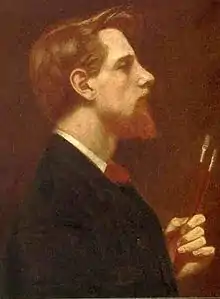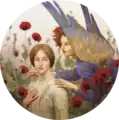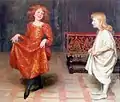


Thomas Cooper Gotch or T. C. Gotch (1854–1931) was an English painter and book illustrator loosely associated with the Pre-Raphaelite movement; he was the brother of John Alfred Gotch, the architect.[1]
Gotch studied art in London and Antwerp before he married and studied in Paris with his wife, Caroline, a fellow artist. Returning to Britain, they settled into the Newlyn art colony in Cornwall. He first made paintings of natural, pastoral settings before immersing himself in the romantic, Pre-Raphaelite romantic style for which he is best known. His daughter was often a model for the colourful depictions of young girls.
His works have been exhibited at the Royal Academy, Royal College of Art and the Paris Salon.
Personal life
Thomas Gotch was born 10 December 1854 in the Mission House in Kettering, Northamptonshire.[2][3][4] He was the fourth son born to Mary Ann Gale Gotch[5][6] and Thomas Henry Gotch (born 1805), who was a shoe maker.[3][4][nb 1] He had an elder brother, John Alfred Gotch, who was a successful architect and author.[5]
In 1881 he married fellow art student Caroline Burland Yates (1854–1945) at Newlyn's St Peter's Church. His daughter, Phyllis Marion Gotch was sometimes a model for her father.[3][nb 2] After completing his studies, Gotch travelled to Australia in 1883.[2] Gotch and his wife settled in Newlyn, Cornwall in 1887. The couple and their daughter were key participants in the Newlyn art colony.[2][3]
In addition to his time spent in France and Belgium while studying art, Gotch also travelled to Austria, Australia, South Africa, Italy and Denmark.[4]
Thomas Cooper Gotch died on 1 May 1931 of a heart attack while in London for an exhibition. He was buried in Sancreed churchyard in Cornwall.[2][7]
Education
With his parents' support,[4] in 1876 and 1877 he first studied at Heatherley's[8] art school in London and then at Koninklijke Academie voor Schone Kunsten in Antwerp in 1877 and 1878. Then in 1879 Gotch attended Slade School of Fine Art with Alphonse Legros in London. Gotch met his friend Henry Scott Tuke and his future wife Caroline Yates at Slade. After their marriage, Thomas and Caroline studied in Paris at Académie Julian and Académie Laurens in the early 1880s. It was in Paris that he adopted the plein-air approach of painting outdoors.[2][3][9]
Career
In Newlyn he founded the Newlyn Industrial Classes, where the local youth could learn the arts & crafts. He also helped to set up the Newlyn Art Gallery, and served on its committee all his life. Among his friends in Newlyn was fellow artist Stanhope Forbes[2] and Albert Chevallier Tayler.[10]
In Newlyn, like other art colony artists, he used the plein-air approach for making paintings outdoors. He was also inspired by James McNeill Whistler's techniques for creating compositions and paintings.[9]
His style changed following an 1891-1892 a visit to Paris and Florence; His works were transformed from the Newlyn "rural realistic" style to a Pre-Raphaelite style that embraced more vibrant, exuberant colours and "returned to allegorical genre painting". His first such painting was My Crown and Sceptre made in 1892,[2][3][9] Commenting upon his new style, Tate said:
His new combination of symbolic female figures, decorative Italian textiles and the static order of early Renaissance art finally brought him recognition.[9]
On the provisional committee for the 1895 opening of the Newlyn Art Gallery, Gotch exhibited The Reading Hour and A Golden Dream at the inaugural exhibition.[2]
Chris Leuchars for Project Kettering has said of Gotch's work:
Although Thomas Gotch is not widely recognised in international art histories, his position and friendships in Newlyn, and the mastery of his artwork, provide him some level of recognition in British painting history and his works make valuable contributions to collections around the world. He has work in key collections in Australia, New Zealand, South Africa and the United Kingdom.[4]
Thomas Gotch was a recognised success during his lifetime and enjoyed considerable public acclaim. He was a regular exhibitor at London's Royal Academy and contributed to numerous other national and international exhibitions. His works are still regularly exhibited and are often the subject of academic studies.
Over his artistic career Gotch was also a model for other artists. For instance, he modelled for illustrations of King Arthur's Wood for Elizabeth Forbes.[3]
Memberships
He helped establish, was a prominent force or member of the following organizations.[2][9]
|
|
Exhibitions
The following had exhibitions of Gotch's work:[2][11]
|
During his life:
|
Following his death
|
Works
Gotch landscapes, portraits and genre works using watercolour, oil and pastels. The following is a partial list of his works.[2][3][7] Most of his earnings came from painting portraits,[9] particularly children and women.[4]
- A Garden
- A Golden Dream, 1895. Used for theme for 100th anniversary of Newlyn Art Gallery.
- A Jest
- Alleluia, 1896, Tate Gallery. Purchased for the nation. One of the best examples of Gotch's Pre-Raphaelite works.
- Blossom (Girl in a Cornish garden)
- Crossing the Bar, 1923
- Dalaphne
- Dawn of Womanhood, 1900
- Death the Bride, 1894/5
- Evening
- Fireside Story
- Girl at Porch, Chywoone Hill, Newlyn, 1889, oil, Penlee House
- Girl in a Cornish Garden, Penlee House
- Harvest
- Heir to All the Ages, 1897
- High Velt, South Africa, 1910
- It is an Ancient Mariner, 1925
- John Alfred Gotch, 1926
- Mental Arithmetic
- Mounts Bay
- Mounts Bay, Autumn, 1905
- Mrs Sherwood Hunter, oil on canvas
- My Crown and Sceptre, 1892. First Pre-Raphaelite style painting.
- Penzance from Newlyn
- Portrait of a girl with eyes closed, charcoal
- Portrait of Phyllis Gotch in Blue, 198?
- Self Portrait, 1912
- Sharing Fish, ca. 1910, Royal Cornwall Museum, Truro
- Sir William Drake in the Morning Room, 1885
- Study of a Young Woman
- Study for 'The Birthday Party
- The Awakening
- The Birthday, 1930
- The Child Enthroned, 1894
- The Clarinet Player
- The Dancing Lesson
- The Exile
- The Flag, 191?
- The Lantern Parade, 1910
- The Madonna of the Mount, 1926
- The Message 1903
- The Mother Enthroned, 1912-1919
- The Nymph, 1920
- The Nymph and The Exile, 1929–30
- The Orchard, 1887, notable early work
- The Pageant of Children, 1895
- The Reading Hour, 1895
- The Return From The Pageant, 1907
- The Sailor's Farewell, oil, Penlee House
- The Story of the Money Pig
- The Vow, 1920s?
- The Wizard, notable early work
- Young Girl Reading a Manuscript
Gallery
 The Orchard, 1887
The Orchard, 1887 Sharing Fish, 1891
Sharing Fish, 1891 Death the Bride (1894/5)
Death the Bride (1894/5) The Pageant of Childhood, 1895
The Pageant of Childhood, 1895 Alleluia, 1896
Alleluia, 1896 The Message, 1903
The Message, 1903 The Flag, 1910
The Flag, 1910 The Mother Enthroned, 1912-1919
The Mother Enthroned, 1912-1919 The Exile, 1930
The Exile, 1930 A Jest
A Jest La Reine Clothilde
La Reine Clothilde Monsigneur Love
Monsigneur Love Study of a Young Woman
Study of a Young Woman The Awakening
The Awakening The Dancing Lesson
The Dancing Lesson The Dawn of Womanhood
The Dawn of Womanhood They Come
They Come
Gotch collaborated with John Drew Mackenzie on a set of copper plates that represents air, earth, fire and water, melding the styles of both artists in a symbolic Biblical theme.[2]
Notes
References
- ↑ Thomas Gotch Cooper. Art Encyclopedia.
- 1 2 3 4 5 6 7 8 9 10 11 12 13 Thomas Cooper Gotch. Cornwall Artists. Retrieved 4 October 2012.
- 1 2 3 4 5 6 7 8 9 Thomas Cooper Gotch. Penlee House. Retrieved 5 October 2012.
- 1 2 3 4 5 6 7 Thomas Cooper Gotch. Project Kettering. Manor House Museum, Kettering. Retrieved 5 October 2012.
- 1 2 Historical collections relating to Northamptonshire: family histories, pedigrees, biographies, tracts on witches, historical antiquities, reprints of rare and unique tracts .... Printed by J. Taylor & Son; 1896. p. 115.
- ↑ Pamela Lomax. The golden dream: a biography of Thomas Cooper Gotch. Sansom & Co.; 2004. ISBN 978-1-904537-21-2. p. 26.
- 1 2 3 "Tate Collection's Alleluia". Retrieved 2 February 2012.
- ↑ "GOTCH, Thomas Cooper". Who's Who. Vol. 59. 1907. p. 706.
- 1 2 3 4 5 6 Thomas Cooper Gotch. Tate. Retrieved 5 October 2012.
- ↑ Pamela Lomax. The golden dream: a biography of Thomas Cooper Gotch. Sansom & Co.; 2004. ISBN 978-1-904537-21-2. p. 10.
- ↑ Thomas Cooper Gotch: Biography and Image Gallery. Archived 14 March 2012 at the Wayback Machine ArtMagick. Retrieved 20 February 2012.
Further reading
- Baldry, A. L. "The Work of T. C. Gotch", The Studio, Vol.13, March 1898, pages 73–82.
- Lomax, Pamela. The Golden Dream: A Biography of Thomas Cooper Gotch. Sansom & Company, 2004.
- Lomax, Pamela. A Winter in Florence 1891-1892. Shears & Hogg, 2001
- Lomax, Pamela. A Long Engagement. Shears & Hogg, 2002.
- Virag, Rebecca.Thomas Cooper Gotch: A Painter of Childhood, Motherhood and Empire. Unpublished M.A. thesis, Courtauld Institute of Art, 1997.
- Virag, Rebecca. Images of Inheritance: The influence of eugenic ideas and socio-biological theory in late-nineteenth-century and early-twentieth-century British art (c.1890-1918). Unpublished Ph.D. thesis, Courtauld Institute of Art, 2003.
External links
 Media related to Thomas Cooper Gotch at Wikimedia Commons
Media related to Thomas Cooper Gotch at Wikimedia Commons